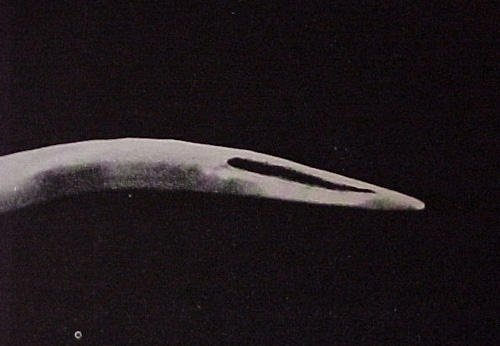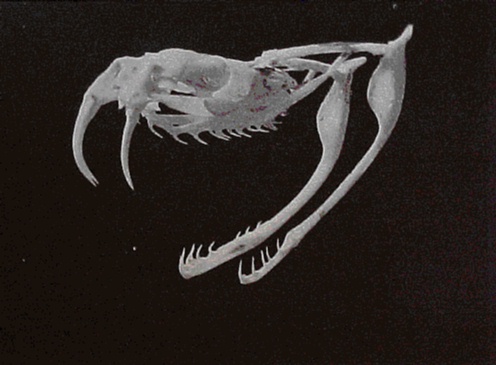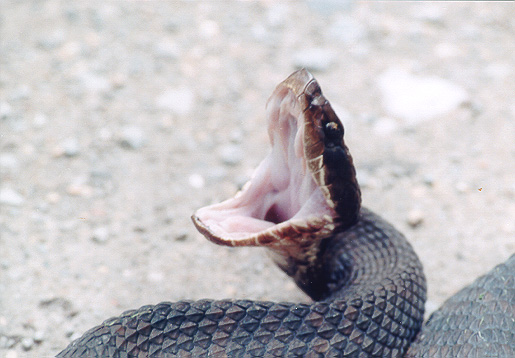The Great Moccasin Migration (continued)
The pit is easily seen on this Copperhead.

Fang closeup,
adapted from Ditmars.

The
fangs as part of the skull structure, adapted from Ditmars.

Here the snake
displays, but the fangs are folded back and sheathed.
The Cottonmouth, along with Copperheads, Rattlesnakes, and others, is a pit viper. The "pit" is a specialized heat sensitive organ, located on each side of the head, about midway between the eye and nostril, easily seen in the Copperhead image to the left. These pits aid the serpent in determining the exact location of warm-blooded prey, enabling it to strike accurately. Functioning much like a pair of eyes that can see in the infrared range, the pits are sophisticated enough to differentiate between a warm breeze and a radiant object, such as a mouse. The information from the heat pits is processed by the same areas of the brain that handle vision, and as a result, the snakes' "image map" of an object combines both infrared and visible light.
The "fangs" of Cottonmouths and other vipers are actually specialized teeth, encased in a sheath of tissue. The fangs are hollow, with a small opening near the tip, much like a hypodermic needle. A small duct connects each fang to a large venom gland on each side of the head, underneath the eye. The teeth are hinged at their base, and swing inwards when the mouth is closed, and lie within the protective sheath. When the serpent bites (a "strike" is a bite), the mouth opens, the fangs swing forward, protruding from the sheaths, and muscular contractions force venom from resevoirs in the venom glands to the fangs via the venom ducts. It is over in a second.
In their book Venomous Reptiles, Minton and Minton table the venom yield for an average adult Moccasin at 100 - 150 mg, and the estimated lethal dose for an adult at 100 mg. Fatalities are uncommon, but the potential is there. A non-fatal bite can still be excruciatingly painful and potentially crippling. Cottonmouth venom is haemotoxic, affecting the circulatory system and body tissues. It breaks down and necrotizes even hard muscle tissues. There is severe swelling around the bite, sometimes affecting the entire appendage. Gangrene oftentimes necessitates the amputation of fingers, toes, and even limbs.
Of course, the venom apparatus is designed to subdue prey and start the digestion process, rather than to kill human beings. After being bitten, the prey animal is incapacitated by the powerful venom within seconds, and death usually follows soon after. Using its tongue, the snake locates the fallen prey and swallows it whole. With some small prey items, the snake may simply hang onto it and begin the swallowing process.